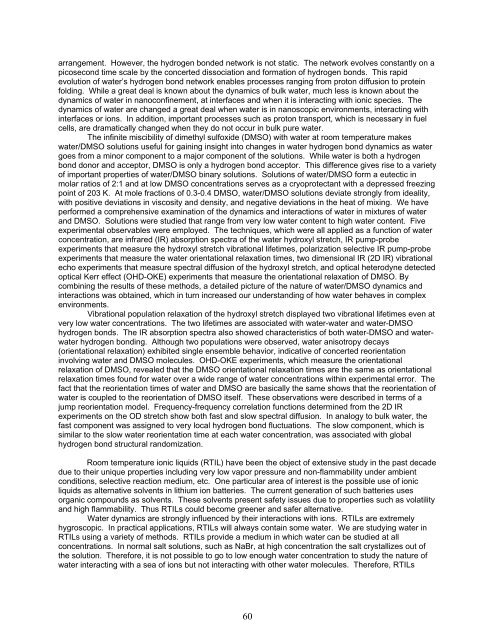Eighth Condensed Phase and Interfacial Molecular Science (CPIMS)
Eighth Condensed Phase and Interfacial Molecular Science (CPIMS)
Eighth Condensed Phase and Interfacial Molecular Science (CPIMS)
Create successful ePaper yourself
Turn your PDF publications into a flip-book with our unique Google optimized e-Paper software.
arrangement. However, the hydrogen bonded network is not static. The network evolves constantly on a<br />
picosecond time scale by the concerted dissociation <strong>and</strong> formation of hydrogen bonds. This rapid<br />
evolution of water’s hydrogen bond network enables processes ranging from proton diffusion to protein<br />
folding. While a great deal is known about the dynamics of bulk water, much less is known about the<br />
dynamics of water in nanoconfinement, at interfaces <strong>and</strong> when it is interacting with ionic species. The<br />
dynamics of water are changed a great deal when water is in nanoscopic environments, interacting with<br />
interfaces or ions. In addition, important processes such as proton transport, which is necessary in fuel<br />
cells, are dramatically changed when they do not occur in bulk pure water.<br />
The infinite miscibility of dimethyl sulfoxide (DMSO) with water at room temperature makes<br />
water/DMSO solutions useful for gaining insight into changes in water hydrogen bond dynamics as water<br />
goes from a minor component to a major component of the solutions. While water is both a hydrogen<br />
bond donor <strong>and</strong> acceptor, DMSO is only a hydrogen bond acceptor. This difference gives rise to a variety<br />
of important properties of water/DMSO binary solutions. Solutions of water/DMSO form a eutectic in<br />
molar ratios of 2:1 <strong>and</strong> at low DMSO concentrations serves as a cryoprotectant with a depressed freezing<br />
point of 203 K. At mole fractions of 0.3-0.4 DMSO, water/DMSO solutions deviate strongly from ideality,<br />
with positive deviations in viscosity <strong>and</strong> density, <strong>and</strong> negative deviations in the heat of mixing. We have<br />
performed a comprehensive examination of the dynamics <strong>and</strong> interactions of water in mixtures of water<br />
<strong>and</strong> DMSO. Solutions were studied that range from very low water content to high water content. Five<br />
experimental observables were employed. The techniques, which were all applied as a function of water<br />
concentration, are infrared (IR) absorption spectra of the water hydroxyl stretch, IR pump-probe<br />
experiments that measure the hydroxyl stretch vibrational lifetimes, polarization selective IR pump-probe<br />
experiments that measure the water orientational relaxation times, two dimensional IR (2D IR) vibrational<br />
echo experiments that measure spectral diffusion of the hydroxyl stretch, <strong>and</strong> optical heterodyne detected<br />
optical Kerr effect (OHD-OKE) experiments that measure the orientational relaxation of DMSO. By<br />
combining the results of these methods, a detailed picture of the nature of water/DMSO dynamics <strong>and</strong><br />
interactions was obtained, which in turn increased our underst<strong>and</strong>ing of how water behaves in complex<br />
environments.<br />
Vibrational population relaxation of the hydroxyl stretch displayed two vibrational lifetimes even at<br />
very low water concentrations. The two lifetimes are associated with water-water <strong>and</strong> water-DMSO<br />
hydrogen bonds. The IR absorption spectra also showed characteristics of both water-DMSO <strong>and</strong> waterwater<br />
hydrogen bonding. Although two populations were observed, water anisotropy decays<br />
(orientational relaxation) exhibited single ensemble behavior, indicative of concerted reorientation<br />
involving water <strong>and</strong> DMSO molecules. OHD-OKE experiments, which measure the orientational<br />
relaxation of DMSO, revealed that the DMSO orientational relaxation times are the same as orientational<br />
relaxation times found for water over a wide range of water concentrations within experimental error. The<br />
fact that the reorientation times of water <strong>and</strong> DMSO are basically the same shows that the reorientation of<br />
water is coupled to the reorientation of DMSO itself. These observations were described in terms of a<br />
jump reorientation model. Frequency-frequency correlation functions determined from the 2D IR<br />
experiments on the OD stretch show both fast <strong>and</strong> slow spectral diffusion. In analogy to bulk water, the<br />
fast component was assigned to very local hydrogen bond fluctuations. The slow component, which is<br />
similar to the slow water reorientation time at each water concentration, was associated with global<br />
hydrogen bond structural r<strong>and</strong>omization.<br />
Room temperature ionic liquids (RTIL) have been the object of extensive study in the past decade<br />
due to their unique properties including very low vapor pressure <strong>and</strong> non-flammability under ambient<br />
conditions, selective reaction medium, etc. One particular area of interest is the possible use of ionic<br />
liquids as alternative solvents in lithium ion batteries. The current generation of such batteries uses<br />
organic compounds as solvents. These solvents present safety issues due to properties such as volatility<br />
<strong>and</strong> high flammability. Thus RTILs could become greener <strong>and</strong> safer alternative.<br />
Water dynamics are strongly influenced by their interactions with ions. RTILs are extremely<br />
hygroscopic. In practical applications, RTILs will always contain some water. We are studying water in<br />
RTILs using a variety of methods. RTILs provide a medium in which water can be studied at all<br />
concentrations. In normal salt solutions, such as NaBr, at high concentration the salt crystallizes out of<br />
the solution. Therefore, it is not possible to go to low enough water concentration to study the nature of<br />
water interacting with a sea of ions but not interacting with other water molecules. Therefore, RTILs<br />
60
















